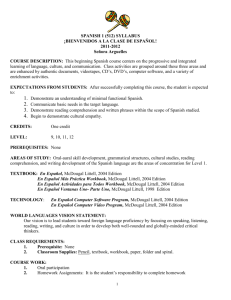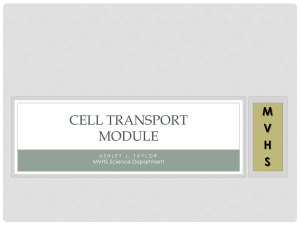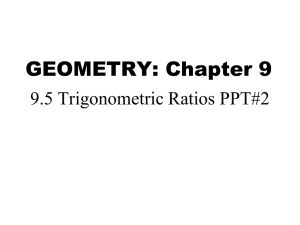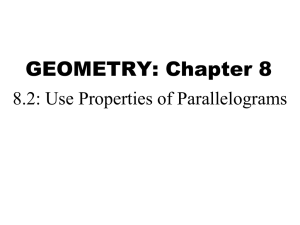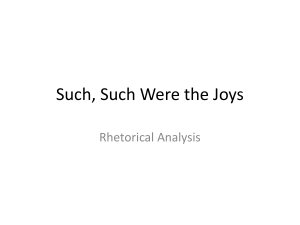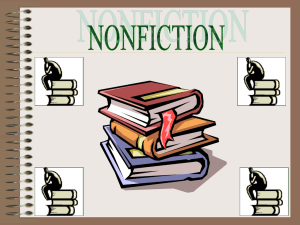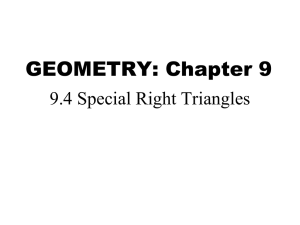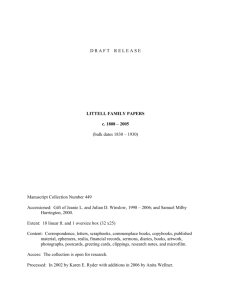“I Have a Dream” (Info - Chandler Unified School District
advertisement
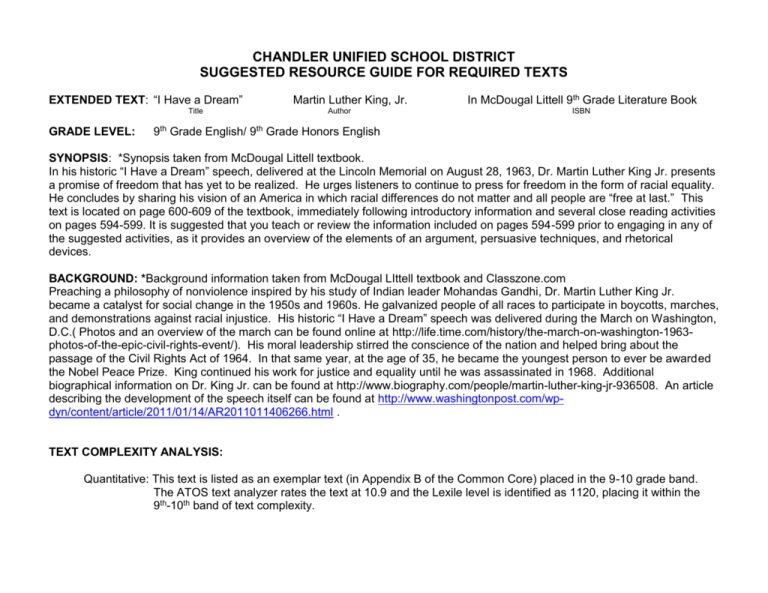
CHANDLER UNIFIED SCHOOL DISTRICT SUGGESTED RESOURCE GUIDE FOR REQUIRED TEXTS EXTENDED TEXT: “I Have a Dream” Title GRADE LEVEL: Martin Luther King, Jr. Author In McDougal Littell 9th Grade Literature Book ISBN 9th Grade English/ 9th Grade Honors English SYNOPSIS: *Synopsis taken from McDougal Littell textbook. In his historic “I Have a Dream” speech, delivered at the Lincoln Memorial on August 28, 1963, Dr. Martin Luther King Jr. presents a promise of freedom that has yet to be realized. He urges listeners to continue to press for freedom in the form of racial equality. He concludes by sharing his vision of an America in which racial differences do not matter and all people are “free at last.” This text is located on page 600-609 of the textbook, immediately following introductory information and several close reading activities on pages 594-599. It is suggested that you teach or review the information included on pages 594-599 prior to engaging in any of the suggested activities, as it provides an overview of the elements of an argument, persuasive techniques, and rhetorical devices. BACKGROUND: *Background information taken from McDougal LIttell textbook and Classzone.com Preaching a philosophy of nonviolence inspired by his study of Indian leader Mohandas Gandhi, Dr. Martin Luther King Jr. became a catalyst for social change in the 1950s and 1960s. He galvanized people of all races to participate in boycotts, marches, and demonstrations against racial injustice. His historic “I Have a Dream” speech was delivered during the March on Washington, D.C.( Photos and an overview of the march can be found online at http://life.time.com/history/the-march-on-washington-1963photos-of-the-epic-civil-rights-event/). His moral leadership stirred the conscience of the nation and helped bring about the passage of the Civil Rights Act of 1964. In that same year, at the age of 35, he became the youngest person to ever be awarded the Nobel Peace Prize. King continued his work for justice and equality until he was assassinated in 1968. Additional biographical information on Dr. King Jr. can be found at http://www.biography.com/people/martin-luther-king-jr-936508. An article describing the development of the speech itself can be found at http://www.washingtonpost.com/wpdyn/content/article/2011/01/14/AR2011011406266.html . TEXT COMPLEXITY ANALYSIS: Quantitative: This text is listed as an exemplar text (in Appendix B of the Common Core) placed in the 9-10 grade band. The ATOS text analyzer rates the text at 10.9 and the Lexile level is identified as 1120, placing it within the 9th-10th band of text complexity. Qualitative: One of the most well-known speeches of all time, “I Have a Dream” is rich with vivid imagery and lends itself to a deep study of rhetorical devices and the elements of an argument. Specifically, the rhetorical devices of repetition, parallelism, and analogy can be found throughout the text and can be analyzed for their purpose and impact on the text as a whole. Reader and Task: This text is appropriately challenging for students in 9th grade. It is appropriately complex and will challenge young readers due to the use of figurative language and rhetorical devices, making it an ideal text for beginning rhetorical analysis. Since the text is included in the McDougal Littell Literature book, there are activities provided in the teacher’s edition to facilitate differentiation for both advanced readers as well as English learners and less proficient readers. Although the text is not exceptionally lengthy, the teacher might consider studying a shorter excerpt of the speech with students who fall far below the 9 th grade reading level. ESSENTIAL QUESTIONS: How can we influence others? (taken from McDougal Littell textbook) Can a dream change the world? (taken from McDougal Littell textbook) When should an individual take a stand against what he/she believes to be an injustice? What are the most effective ways to do this? (taken from http://www.greece.k12.ny.us/academics.cfm?subpage=923) How can language be used to empower as well as to control individuals? MOTIFS AND THEMES: Themes: Motifs: Equality Freedom Hope Racial Injustice/Social Justice LANGUAGE: Identify important vocabulary. Provide a focus standard for grammar/mechanics that works nicely with the extended text. Vocabulary Acquisition and Use Tier 2 Vocabulary Tier 3 Vocabulary (if applicable) Momentous (line 4) Defaulted (line 21) Legitimate (line 37) Militancy (line 52) Inextricably (line 56) Exalted (line 99) Five score (line 3) Promissory note (line 17) Gradualism (line 31) Nullification (line 96) Conventions of Standard English or Knowledge of Language focus standard: Standard Code L.9-10.1a Standard Text Use parallel structure. Description of where and how it fits with the extended text Martin Luther King Jr employs parallel structure throughout his speech. A particularly effective example is in lines 71-92. COMPANION TEXTS: Provide a series of short companion texts that will supplement the extended text and provide students with a deeper understanding of the themes, motifs, or context of the extended text. 1-3 Short Informational Texts Text Title and Author 1. “AIn’t I a Woman?” Speech by Sojourner Truth A short description of the text and how it relates to the extended text Label Difficulty: Advanced Grade Level Meant for Scaffolding 1. Sojourner Truth (1797-1883) was born into slavery and later became a well-known and outspoken anti-slavery speaker. She delivered the speech “Ain’t I a Woman?” at the Women’s Convention in Akron, Ohio, on May 29, 1851. Both Truth and MLK Jr. use parallelism and repetition for rhetorical effect. These speeches could also be compared in terms of the effect, purpose, and type of persuasive techniques used. 1. Grade level (lower end) 2. Warren Opinion: Brown v. Board of Education 2. This text can be easily found online, and is available at http://www.nationalcenter.org/brown.html. This legal decision abolished the idea of separate but equal in public education. The teacher could choose an excerpt or two from this legal document and conduct a close reading with students. The motifs of equality and justice could be compared between the Warren Opinion and “I Have a Dream.” 2. Advanced 3. Bryan Stevenson: We need to talk about an injustice (a TED talk) 3. This 23 minute TED talk and it’s transcript can be found online at TED.com. While viewing the video students could practice identifying the speaker’s claim, reasons, evidence, and persuasive techniques. The motif of social justice and societal injustice could be discussed and connected to King’s speech. 3. Grade level 1-3 Short Literary Texts Text Title and Author A short description of the text and how it relates to the extended text Excerpt from “Rosa Parks” biography by Douglas Brinkley (located in the McDougal Littell 9th grade literature textbook, page 274) 1. This excerpt from a biography of Rosa Parks details the historic moment when the civil rights icon politely refused to move to the back of the bus. This excerpt could be compared with “I Have a Dream” thematically in order to answer the essential question When should an individual take a stand against what he/she believes to be an injustice? What are the most effective ways to do this? The text is also rich with allusions, as is MLK Jr’s speech, and could be analyzed for the effect of an author’s choices on tone and meaning. 2. To Kill a Mockingbird by Harper Lee 2. This novel is set in the American south during the 1930s and centers around the trial of Tom Robinson. The motifs of social justice, equality, hope, and freedom are present throughout the novel and connect well with the ideas in King’s speech. 3. Atticus Finch’s closing argument from To Kill a Mockingbird (video/audio clip) 3. In a short clip from the movie version of the novel To Kill a Mockingbird, Atticus Finch delivers his closing argument in the trial of Tom Robinson. Students could analyze the types of persuasive appeals used in the speech and compare the effect and tone of the speech to King’s “I Have a Dream”. This can be found online at http://www.americanrhetoric.com/MovieSpeeches/moviespeechtokillamockingbird. html 1. Label Difficulty: Advanced Grade Level Meant for Scaffolding 1. Grade level 2. Grade Level 3. Grade Level 4. 4. Caged Bird by Maya Angelou (poem in McDougal Littell textbook on page 246) 4. This short poem ties to the idea of freedom presented in King’s speech. Students could read and discuss the poem in class and then be encouraged to independently find additional poems that connect to the motifs in King’s speech. These poems could then be used as part of a synthesis writing assignment. Meant for Scaffolding STANDARDS-BASED ACTIVITIES: These activities will assist in the instruction of the extended text (consider: comprehension, vocabulary, grammar, close reading, etc.). Some materials (rubrics, graphic organizers, printables, handouts, student directions, etc.) will be added to the end of this document. Description ACTIVITY: IDENTIFY THE ELEMENTS OF AN ARGUMENT Resources: Copy of “I Have a Dream Speech” Delineating and evaluating the argument and specific claims in a text and Standards Addressed: assessing whether the reasoning is valid and the evidence is relevant and RI.9-10.8 sufficient, are key skills when evaluating argumentative writing, as well as a focus RI.9-10.2 skill in unit 6 of the McDougal Littell literature textbook. Before reading the text, students should review the elements of an argument on pages 594 and R21-R23 of the textbook. If possible, students should be provided with a copy of MLK Jr’s “I Have a Dream” speech on which they can annotate. If this is not feasible, then students could use sticky notes to annotate the speech in the textbook. Students should then view or listen to the speech, and could read along to increase comprehension. A video of Dr. King delivering his speech is available on Youtube.com. As they watch the video, students should consider what is the central idea of King’s speech? How does this central idea evolve over the course of the speech? They should write a short response to this prompt after viewing. WRITING PROMPTS: Argument/Opinion Prompt: o Part of King’s eloquence in “I Have a Dream” comes from his religious references. Read and reflect on the Bible passages which King quotes in the speech: Amos 5:24 (line 69-70) and Isaiah 40:4-5 (lines 99-102). In a fully developed essay, have students summarize the context of the quotations, reflect on why King quoted them, and evaluate their effectiveness. (taken from the McDougal Littell Resource Manager resources) Informational/Explanatory Prompt: o Students determine the purpose and point of view in Martin Luther King, Jr.’s, “I Have a Dream” speech and analyze how King uses rhetoric to advance his position. [RI.9–10.6] *taken from the Common Core Appendix B Narrative Prompt: o Research Prompt: o Research another leader-author who hoped to set an injustice right within society. Compare a selection of writing (or art, media, speech, poem, etc.) to King’s speech. Write an essay where you focus on how the message was communicated an what made it effective. As outlined by PARCC, the prompts above may occur in a variety of writing environments. Teachers should consider: Incorporating a mix of on-demand and review-and-revision writing assignments Including routine writing, such as short constructed-responses to text-dependent questions, to build content knowledge and provide opportunities for reflection on a specific aspect of a text or texts Integrating of a number of analytic writings that places a premium on using evidence, as well as on crafting works that display some logical integration and coherence. These responses can vary in length based on the questions asked and task performed, from answering brief questions to crafting longer responses, allowing teachers to assess students’ ability to paraphrase, infer, and ultimately integrate the ideas they have gleaned from what they have read. Over the course of the year, analytic writing should include comparative analysis and compositions that share findings from the research project Include narrative writing to offer students opportunities to express personal ideas and experiences; craft their own stories and descriptions; and deepen their understandings of literary concepts, structures, and genres (e.g., short stories, anecdotes, poetry, drama) through purposeful imitation.
